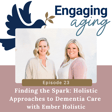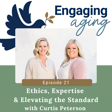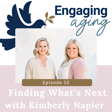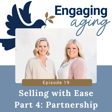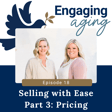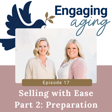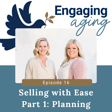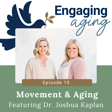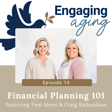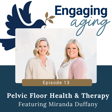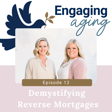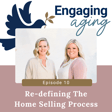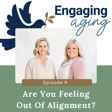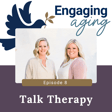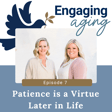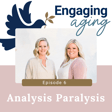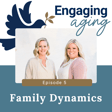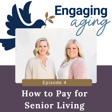Introduction to Neuroplasticity and Emotional Modulation
00:00:00
Speaker
Did you know that mindset really isn't a thing? That we are actually neuroplastic humans, which means we're not ever really set in one state of mind.
00:00:10
Speaker
We have the ability to modulate between emotions to create new outputs once we create new inputs into our nervous system. We talk about all of this and so much more in this fascinating episode of Engaging Aging with Elizabeth Christophe, neuroscience extraordinaire,
00:00:29
Speaker
where we understand the mind-body connection and how emotions live in our physical body and what we can do about that to help clear the chaos in our lives and move forward with so much more ease.
00:00:42
Speaker
We hope you take a minute, dive in and listen to this podcast episode because it has been a game changer and a life changer for me and the clients who I serve. Enjoy.
Meet the Hosts: Erin DeCarlo and Lauren Watts
00:00:52
Speaker
Welcome to Engaging Aging. I'm Erin DeCarlo. And I'm Lauren Watts.
00:00:56
Speaker
We believe life gets richer with age, and we're here to prove it. We bring you real conversations about aging well, living fully, and navigating this journey with confidence.
00:01:07
Speaker
So let's dive in, because aging isn't something to endure, it's something to embrace.
00:01:15
Speaker
I am having a full pinch me moment. um I, for any of my listeners, I am a huge fan of Kate Northrup and her podcast, Plenty. And I think I binged like so many episodes last year, but there was one particular guest who had me at hello and she is our guest today. And it feels surreal to have you here, Elizabeth.
00:01:38
Speaker
Please welcome Elizabeth Kristoff from the Neurosomatic Intelligence and Brain-Based Wellness and Trauma Rewired. the things. Yeah. well I'm like floating on cloud nine over here. Thank you for joining us today.
00:01:53
Speaker
oh thank you so much for having me. It is an honor to be here. I love the work that you're doing in the world. And I'm so excited to have this conversation with you today.
Challenging Aging Misconceptions
00:02:03
Speaker
Thank you. Thank you.
00:02:04
Speaker
So as our listeners know, we are all about aging well, and that takes a lot of different ways. scenarios, paths, roadways for people to get to. What does it mean to age well for them?
00:02:17
Speaker
And so for all of the years, 22 years that I've been working in the older adult space, we kind of have this thought that older people are kind of set, like they are who they are and people get worse with age and the doom and gloom around aging. But what I have witnessed firsthand time and time again is that no one is set.
00:02:39
Speaker
And that mindset isn't really a thing. And when I learned about the nervous system and how it informs our behaviors and our personalities and our decision making, i was so excited to fully dive in with your course and learn more. And I thought it was to help serve all of my clients.
00:02:59
Speaker
And then I realized immediately that charity begins at home. And that when we can do this work for ourselves, first and foremost, understand our own individual nervous system day in and day out, that's where we can really start to impact and have a ripple
Gaining Agency through Nervous System Understanding
00:03:14
Speaker
effect out in the world. So I'd love to open it up to you for people to understand what is nervous system healing? Why does this matter? And then maybe we can talk about older adults more specifically.
00:03:24
Speaker
Oh, well I think it matters so much for exactly what you were talking about. All of us, we have a brain, we have a nervous system, we have a body, and we're just not taught how we work, how to know ourselves at that deep level.
00:03:38
Speaker
And when we learn about ourselves, that gives us real agency in our life, because the truth is, like you were saying, we are never stuck. Science is that we are neuroplastic beings, like we're so much more plastic and adapting and changing than people think. Our brain is not even actually a solid matter. It's like a gelatinous substance. If you put it into a another container, it would change shape. Like it is constantly remolding and responding to the world around us and our environment.
00:04:12
Speaker
And we just don't understand how to work. with our own brain and nervous system to create that change in a direction that we want. So we think that these things are set, that we're going to have more pain as we get older, that we're going to lose our eyesight, that our behaviors are just who we are, you know, whether that's substance abuse or...
00:04:32
Speaker
binge eating or social anxiety, that these are just how we are. But all of those things are just outputs of the way that our nervous system
Nervous System Overview: Central vs Peripheral
00:04:40
Speaker
functions. And when we know how to work with our nervous system, we can create change in any of these areas because that's the the root level.
00:04:48
Speaker
wow Can you give just a basic overview? What is a nervous system? Like, what is this thing we're referring to? Yeah, so our nervous system is comprised of two parts. We have our central nervous system and our peripheral nervous system. And your central nervous system is like your brain and your spinal cord.
00:05:06
Speaker
And then your peripheral nervous system is all of the nerves that take that information from your brain and spinal cord out into your body and also take information from your body back to your brain and your spinal cord.
00:05:17
Speaker
And our nervous system is really how we understand the world around us and the world inside of us. So all of the time. every single second of the day, my system is taking in information through my different sensory systems, through my eyes, the balance system in my inner ear, my body mapping system, the system inside of me called my interoceptive system. You can just think of that as your internal perception.
00:05:44
Speaker
And it's telling your brain what's going on inside of your body. And your brain is collecting all of this data every single second. running it through some filters and interpreting it and deciding what it means and asking a really important question.
00:06:02
Speaker
Am i safe or not safe? And then based on the answer to that question, we experience outputs. So our nervous system works like this. We take in the information, our brain interprets it, and then it
Impact of Early Experiences on Nervous System Patterns
00:06:15
Speaker
generates an output. And so everything we experience is an output of that decision, safe or unsafe.
00:06:20
Speaker
So do I move into, changes in my body, like a racing heart, or am I breathing faster? Do my muscles start bracing, but also how are my thoughts shaped by those outputs? How but are my behaviors shaped by those outputs? So everything is kind of happening in that loop. I'm taking an information, interpreting it and driving an output. And that's how our nervous system works all of the time.
00:06:47
Speaker
I think one thing that's fascinating is that all of this is, I'm assuming, developed in early childhood. Like what we're witnessing for safety, a lot of this, most of this is happening behind the scenes subconscious.
00:07:00
Speaker
And it's for me, what's very interesting to discuss is what came first, the chicken or the egg. Like so many people think because I'm having anxious thoughts, I'm My body, you know, I have a pit in my stomach or I'm breathing rapidly or whatever, not realizing. And I would love to break down actually the word neurosomatic, the mind body connection.
00:07:21
Speaker
And the real aha moment is that the body is actually having the physical sensation before the thought goes. even begins, right? Because the primal brain is happening first before the the new brain, so to say.
00:07:36
Speaker
Can you explain that a little bit about how this begins early in life and kind of stays with us over time? Yeah, so I'll speak to that part first and then we'll talk about the relationship between the mind and the body because these patterns are, they come from our early development.
00:07:54
Speaker
As our nervous system is learning how to move through the world, we develop patterns, movement patterns, breathing patterns, different ways of interpreting sensory input.
00:08:06
Speaker
And that can also go to social doneette dynamics as well, right? How do I interpret someone's vocal tone or their posture? How am I staying safe physically, but also emotionally and socially?
00:08:19
Speaker
But again, even though these things are patterned in early development, that doesn't mean they're stuck that way because our nervous system is constantly... Adapting and responding to the sensory stimulus that comes in to the world around us to our different experiences.
00:08:36
Speaker
So my nervous system is going to be always really wired for efficiency. And so if I'm not... training it in these different skills, working with it to improve its health, it's going to go down the same well-worn path that those things that started in early development. And that's important, especially if you come from and a childhood where there is a lot of stress or trauma, or you have a high ACE scores, your system's going to be much more patterned to be in a hypervigilant state.
00:09:07
Speaker
You're going to get more activated more of the time. You'll respond differently to social cues, your filters of how you see the world might change. That's why we see these greater health outcomes that are greater negative health outcomes for people who have higher levels of developmental trauma, because that is the well-worn path. Those protective responses are what our system knows will keep us safe.
00:09:30
Speaker
But we can still work with our system to repattern it so that as we're giving it new stimulus We're training it in these different skills, teaching it how to modulate and respond to things differently.
00:09:43
Speaker
These new reactions become well-worn paths as well. And now when we're in the same situations, we have a different choice. We have a different choice of how to respond at that subconscious level.
00:09:55
Speaker
So we create a different state inside. And so it's always possible, even if we are patterned that way, even if that is the more efficient pathway, once we know how to work with our brain and our nervous system, we can start to create some change in that.
00:10:08
Speaker
And so, yes, it does come from our early development, but we are still changing as we as we grow up, as we move into adulthood, and even as we age, we're still adapting.
00:10:20
Speaker
I love that. And one thing that I think intimidated me before I really knew more about this is like, this would be a lot of cognitive load, a lot of thinking, a lot of talk therapy to make all of this work.
00:10:32
Speaker
And what I realized when I started taking the course, it's the opposite. It's about getting out of your thoughts and into your body with some really simple tools, in my opinion, like simple tools to,
00:10:43
Speaker
um to put into daily practice.
Rehabilitating Sensory Inputs for Better Aging
00:10:46
Speaker
Can you talk a little bit about that body connection, about how this work is the, it's about getting out of your head and into your body? Yeah, the way that we really work through and NSI is rather than trying to focus on the outputs, and again, like everything that we experience is outputs, our pain, our limited range of motion, our vision, how clearly we can see, ah as well as our emotional state, our ability to stay present and connected, these are all outputs.
00:11:16
Speaker
But rather than cognitively trying to think my way into an output, I wanna move better, wanna react differently in this situation, that's not really the language that our nervous system speaks.
00:11:27
Speaker
Our nervous system speaks through sensory inputs. So in NSI, we're really looking at how do I change the input rather than try to change the output. So if I can create a new input, I'm moving from this different place in the loop. I'm giving my brain new information that then creates a new state inside of the body, a new reaction inside of the body, and then that creates a change in the output. So and want to give an example of this because I think it can be kind of abstract for people.
00:11:57
Speaker
When I'm talking about sensory input, i I really mean the information coming in through your sensory systems. So The information coming in from your eyes, the information coming in from the balance system in your inner ear, the information coming in from your body mapping system um that lets your brain know where your body is in space. And then again, your introceptive system, the system inside that tells your brain what's going on in your body.
00:12:21
Speaker
So for example, if I have a deficit, in one of those systems, maybe i have a blurry map of where my foot is in space because I have old injury or just simply because i wear shoes most of my life. So those joints- Or for older adults, neuropathy, like there's just maybe some medication challenges. Yeah. Yes. You've had medications or- maybe chemo or these experiences that cause neuropathy.
00:12:48
Speaker
And so now that map of where my foot is, is blurry. My brain doesn't have a good clear picture of where my foot is in space. And again, my brain takes in all this information to make a prediction and decide safe or unsafe.
00:13:03
Speaker
Well, every single step that I take now is a little bit threatening because my brain doesn't know exactly where my foot is gonna land. And that means i could fall and hit my head. And that very threatening to my brain. It doesn't want me to fall and hit my head.
00:13:18
Speaker
So what you see happen is as people age and these deficits go on, Steps become smaller because it doesn't, your brain doesn't think that it's safe to take a nice big step.
00:13:31
Speaker
You might experience pain in your hip flexor because you're, again, your brain is limiting your range of motion so that the steps are smaller because that is safer when the map is blurry.
00:13:42
Speaker
And then that also affects our emotional and cognitive life as well too, because that stress load of every step that I'm taking is adding stress into my nervous system.
00:13:55
Speaker
Now I'm moving through the world all of the time in a really high stress state. And so I don't have a lot of capacity to take on other stress, job stress, relational stress, without moving into a big protective response, maybe shutdown, dissociation, migraine, chronic pain.
00:14:14
Speaker
And so that That one single deficit of my foot being blurry has so many implications in my life. And so how do I rehabilitate that? I don't want to try to think my way out of maybe the anxiety that's being caused by that stress, or I don't want to tell myself, take bigger steps. That's not going to work. That's not how the nervous system communicates.
00:14:38
Speaker
Instead, I'm going to work intentionally to give my foot sensory stimulus, to move my joints of my foot through complex nonlinear movements, get movement into the mechanoreceptors so that now they're starting to send a signal up to the brain, spend a little bit of time every day intentionally rehabbing that. And I'm talking about like one minute, two minutes a day, bringing my foot back online for my brain And over a couple of weeks, over a month or two, as that starts to rehabilitate, as my system starts to change, I start taking bigger steps.
00:15:11
Speaker
I have less pain in my hip. My posture starts to change. I feel less general threat all of the time. i have more capacity to handle other stress. And I'm not experiencing so many other protective outputs just by working with that one part of the nervous system to clear up that information.
00:15:28
Speaker
Amazing. And for any of the elder care professionals that are listening to this episode, I have a very specific example on like how to adapt and modify this. My mother-in-law, you have to have practice sessions when we're in and NSI. And so my mother-in-law, who's not been able to feel um temperature in her right lower leg for years, and I didn't know that until she told me, um but she has a hard time. She had a a spinal fusion. so we talk about threat.
00:15:52
Speaker
She wasn't able to bend down to do the stimulus on her leg. So I was able to coach her through closing her eyes while I rubbed the area of her leg. It was amazing how immediately the temperature changed, her awareness of her leg and her space and time changed.
00:16:10
Speaker
So like even with modification, there's so much opportunity here to help older adults because I think about at a baseline due to an aging body, there's usually some aspect of our system that needs some attention and we just don't know that and we don't have this information and so...
00:16:29
Speaker
All of those things that are starting to change for our clients. And I hate to say this, but in the aging services industry, people then become labeled with like, oh, Mr. Smith has behaviors or, you know, the the the outburst doesn't seem...
00:16:45
Speaker
proportionate to the stimulus, but really it's because he's living under all of these other changes in his body that are giving him a baseline of stress that the small thing is like that sensory stimulus overload that we as caregivers in this industry could make a massive impact with some small changes.
00:17:05
Speaker
What would you say or like, what are some of the signs that someone is living in? and we didn't even talk about fight, flight, freeze and fawn, but
Understanding the Stress Bucket Concept
00:17:15
Speaker
maybe we'll start with that. Like, what are some of the responses of a nervous system and how can we tell if we're in it or someone we're supporting is in one of these responses?
00:17:25
Speaker
Yeah, so the example you gave was really great because people think that these reactions are part of our personality or just who we are, but they're not. They're frequently occurring reactions due to the level of stress that our nervous system is under.
00:17:43
Speaker
And so I want to back up just a little bit before we dive into the reactions. The way that it works is you can think of your nervous system like a bucket and all of your life stress goes into the bucket. so you have your relational stress and your work stress and the stress of structural systems, oppression, financial stress, all of the things are going into the bucket. Exercise is a stress, lack of sleep is a stress.
00:18:09
Speaker
And then you also have these unseen stressors, right? Like those are the stressors that you know about. And then you have the unseen stressors, which are the deficits in your different input systems that are actually really, really important. And everybody has these deficits.
00:18:25
Speaker
We all look at screens most of the time. We don't use our eyes for the skills that they're meant to be. We all have old injuries that aren't rehab compensations in our gait pattern, the way we walk, compensations in our movement. We take medications that impact these sensory stimulus. And these deficits kind of grow in time because what we do, we get better at. And so if we get used to not using our eyes that much, that is increasing that deficit more and more with time until we take the time to rehabilitate it.
00:18:55
Speaker
So all of these unseen stressors are adding stress into that bucket all of the time. And when the bucket reaches a threshold, that is when you are gonna move into a protective, reflexive trauma response because our system is intelligent and it understands too much stress for too long is not good. And it actually doesn't want you to get pushed into one of those F responses because they're very energy costly. And we can talk about why that is in a moment, but it doesn't want you to go there.
00:19:29
Speaker
So before you get pushed into those F responses, Before your bucket is overflowing, you'll just start to experience those protective outputs. You'll start to have pain or migraine or fatigue or brain fog. These are protective outputs that your intelligent nervous system is using to try to get you to stay safer and reduce the water in the bucket. If you have pain, you'll call in sick to the high stress job. You won't work out. You might not walk around as much. You won't play with your kids.
00:20:04
Speaker
And in that moment, that is safer for your survival mind because it means less input coming into the bucket. And so until we can start to rehabilitate some of these deficits, working at this real sensory level, that stress load is always going to stay there.
00:20:19
Speaker
So even if we put you like on a desert island with only the people that you loved and you had as much money as you possibly wanted, if we didn't work with the nervous system at this level, that stress would still be there and you would still be experiencing protective outputs.
00:20:35
Speaker
And that's just work is brilliant because until we go in and do the work, there's nothing out there that's going to heal the that are inside. Exactly. Exactly.
00:20:46
Speaker
And so then what it looks like when we have a really high stress load all of the time, because of all the life stress and all of these deficits is that we're constantly in a state of dysregulation. And when I say dysregulation, I'm not talking about a flat line. When we talk about nervous system regulation, it doesn't mean being calm all of the time.
00:21:07
Speaker
It's the ability to modulate and respond appropriately to the situation at hand, right? Our nervous system needs to be able to activate us at times so that we can perform, so that I can be here having this conversation with you, so I can go work out, so I can play.
00:21:23
Speaker
But then I need to be able to come down and recover from that state. And so that I have to have this modulation between our parasympathetic, our rest and recovery, and our sympathetic, which is more activation.
00:21:36
Speaker
So we lose this skill of modulation when we're under high stress all of the time. And we get kind of stuck in these chronic stress states where we're either really activated all of the time or we're shut down and we're burnt out and we're depleted of our resources.
00:21:52
Speaker
And so we're not able to flow with life. And then also too, we start to have our behavior be driven by these states of dysregulation. So when I can't modulate, I can't come down and rest and recover.
00:22:08
Speaker
the activation just keeps escalating and I get pushed into fight, flight, which are my really activated states where my heart rate is going to increase, my respiration increases, my body is preparing to escape a threat by either fighting off a predator or running. So it's mobilizing my resources, getting glucose and oxygen to my muscles so that I can run or I can hit hard.
00:22:35
Speaker
and my whole system is preparing to exert a lot of energy. And inside that feels like anxiety or panic or muscle tension or bracing as you're preparing for that.
00:22:48
Speaker
And then when that internal state is that way, our behavior starts to match that, right? i'm If I'm in a constant chronic fight response, I'm always a little bit instigative, right? I'm looking for that way that I'm going to be hurt. I'm always protecting myself.
00:23:05
Speaker
I'm bracing for that. There's that loud external critic always evaluating my relationships or people around me. When I'm in a chronic flight response, I'm always looking for an out.
00:23:17
Speaker
I always have this underlying sense of, I got to have an exit strategy. I need to get out of this difficult conversation, out of this room. And there's this constant sense of urgency that can drive us into overdoing, overworking, overperforming.
00:23:34
Speaker
because i'm that's what lee Sorry to chime in, but like the out, the leaving of the threat is what signals safety. Like I will be safe in this moment. if i am not yeah it's what your system is preparing to do right the body is preparing to run and so inside it feels like i need to run and then my brain is taking that information up and making sense of those internal interoceptive signals so now my filters of what's going on in the world, my thoughts and my emotions are going to start to match that internal state.
00:24:09
Speaker
And so I'm going to look for reasons why i need to run. I'm going to create um experience of the world where it just doesn't feel safe all of the time.
00:24:23
Speaker
ah And where stillness feels very threatening. And that leads into where stillness is the response. Talk a little bit about the freeze response, which I know is not the long-term response, but it's kind of the immediate reaction.
00:24:36
Speaker
We see freeze very frequently with our older adult clients who are feeling kind of stuck. And so there's this immediate freeze response before we can kind of start to move the process forward.
Exploring Freeze and Fawn Responses
00:24:48
Speaker
Yeah. So this is really interesting. but Do you want to get kind of deep into? Yeah. Okay. So. Fight and flight is like the first line of defense in a situation. If you think about an animal in the wild, there's a predator, there's a threat, they're going to either fight it or they're going to run away.
00:25:09
Speaker
yep Sometimes we need a moment. Our nervous system and our brain needs a moment to evaluate the situation and make the decision of what to what to do next.
00:25:19
Speaker
And that is a true freeze response. It's like the deer in the headlights. It's like when something big and activating happens and you just are immobilized for a moment while your system is gathering information and deciding what the most adaptive next response would be.
00:25:38
Speaker
And then we can, we'll usually either freeze to fight or freeze to flee. However, there are times when there is not an escape.
00:25:50
Speaker
And when you're talking about um your elder population, some, a lot of times, probably they're in situations where they cannot run or they cannot fight in that situation. And definitely when we're talking about children growing up in an abusive environment,
00:26:07
Speaker
they don't have the option to run. They need that. They need their caregivers. They need their home for survival. And they don't have the option to fight because it's not a fight that they're going to win.
00:26:19
Speaker
And so then the nervous system does the next most adaptive thing and you freeze to flop or you stay in a state of tonic immobility. And that is actually more parasympathetic. It's just the system shutting down.
00:26:35
Speaker
You probably dissociate during that time. If it was an animal, the animal is caught by the predator. They don't have an escape. So you're your nervous system and your brain are going to adaptively dissociate you from the experience so that you don't have to feel the pain of it. You don't have to experience the dysregulation.
00:26:55
Speaker
You'll feel very heavy, very tired. um Is this where denial would come in? I can't tell you how many times I've heard adult children say to me, I don't get it. My mom is just in complete denial. And I always say denial is a real form of self-preservation.
00:27:11
Speaker
If we don't see it, we don't need to deal with it. And when i there's pretty deep levels of denial that we see within our older adult population. And I see it as a survival tactic. There's not enough internal resourcing or healing done to be able to do the thing that is threatening. And so we're just going to disassociate.
00:27:31
Speaker
And- to get through the day and- It's much to take it in. Yeah, it's too much to take in. It's too dysregulating. It's too overwhelming. Like you said, there there aren't the inner resources there. I don't have the capacity in my nervous system, in my body. i'm not well fueled, well rested.
00:27:49
Speaker
i just can't. And so we will dissociate from these experiences. We don't feel the internal signals. in our body that's telling us like, this is not okay, we get very disconnected from our gut from our instinct.
00:28:04
Speaker
um From ah an emotional experience, a lot of times if you have chronic dissociation, there's that flat affect that goes on all of the time that you just don't feel a lot it's very hard to process and metabolize and move emotions because you've been disconnected from your body and your internal sensations for so long. And a lot of times that dissociative pattern, again, it can happen in the moment because we are under-resourced and we don't have capacity, but it can also be the well-worn path, right? Like in childhood, that was the most adaptive thing for our nervous system.
00:28:40
Speaker
And because we have never rehabilitated and learned to have these skills, that is the response that our system goes to regularly when under stress, because it's what worked in the past to keep us alive. It's the well-worn path.
00:28:57
Speaker
And what's so interesting I'm finding as, you know, we're starting to do this work with our clients, Just asking someone and allowing them the space to go inward. And when I say, tell me, like, close your eyes, take a deep breath. Where do you feel this in your body? And at first, like, what do you mean?
00:29:13
Speaker
Where do I feel this in my body? like, just follow me. Let's relax for a second. Take a breath. Where do you physically feel this? Almost everyone can identify a physical sensation when they just are allowed or given permission to go inward for a minute.
00:29:28
Speaker
It's like you said, we've never, it's it's not common practice in our society to understand how to go inward and what to do. um What's fascinating for me in these, I'm just, everything you're saying, I'm relating to our client experiences is the fawn response where i find so often older adults are following their adult child's
00:29:53
Speaker
how do I say this dynamic, um pushing or like leadership in a certain way, because they're so afraid of losing that connection. Like their adult child is maybe the primary caregiver or the parent child role reversal is happening and it's terrifying to everyone involved.
00:30:14
Speaker
And so we see this fawning happen. And when we encourage our older adult clients to say something to their adult children, to say that this doesn't feel right for me, or can we take a pause and go in a different direction?
00:30:28
Speaker
I'd love for the audience to hear more about the fawn response because you don't hear it as much, but i we see it play out very often in our scenarios. Wow. Yeah, this is a scenario I've never thought about fawn with before, but it makes so much sense when you describe that. So fawn is another one of the Fs that we talk about as trauma responses or stress responses.
00:30:50
Speaker
It's a little bit different from fight, flight, freeze, or flop because it's a behavioral adaptation. So you're still getting the activation, charge inside, but it's kind of this combination of you're feeling activated inside, but also parts of you are becoming immobilized. Your vocal cords, maybe your diaphragm, so your breathing can become shallow.
00:31:12
Speaker
There's sometimes some dissociation with that because there's some self-abandonment that comes with form. There's actually, now that you're saying that, I can see people like kind of shell up in these family meetings and Or just, yeah, they're not. It's very interesting. They're curling into themselves, into that protective, yeah forward, folded, braced in on yourself posture.
00:31:33
Speaker
It's very protective posture. And it's actually reflexive. There's a part of that that's called startle reflex, where we really, um you know, we clench our fists and we round our spine. And it's it's a protective posture.
00:31:46
Speaker
And fawn is... There's really two applications of fawn. One is if we're in a life-threatening situation and we're trying to placate the predator to ensure survival, right? So think of in a sexual assault kind of trauma, maybe placating the predator so that you stay alive.
00:32:05
Speaker
um in a child abuse situation, if there's somebody that breaks into your home, you're trying to like soothe and appease the person, maybe even with your own voice, you're speaking very calmly, you're going along with what they say, because that is the most adaptive to ensure your survival.
00:32:22
Speaker
But there's another more common and very important application of Fawn, which is when we go into this people pleasing you um you know, performative connection with other people to ensure our social safety needs are met.
00:32:41
Speaker
Luis Mojica is a beautiful somatic practitioner and he describes it as it's our body's way of reflexively belonging because that social safety need is very real for our survival. We need relationships to be able to regulate our nervous system, process emotions,
00:33:02
Speaker
There are so many studies looking at the impacts of loneliness on our health and disease. And so this is a real... real survival need. And so we can move into these patterns of maintaining attachment at all costs, at the expense of ourselves and our own expression.
00:33:22
Speaker
And that can also become very reflexive. And so when you describe that dynamic between um ah parent and their adult child, and really wanting to and do anything that they need to to agree with whatever to maintain that relationship that relationship is clearly so important for their survival and so of course it makes sense that they would start to get patterned and to do this because on many ways physically emotionally socially they need early age I mean yeah all of it financially yeah
00:33:54
Speaker
The loneliness piece really speaks volumes to us for so many different reasons. um Obviously, for older adults, they may have outlived their social. um They've lost a spouse. Many of our clients in this generation were married for 50, 60 plus years.
00:34:09
Speaker
And I think that due to ageism. It's just assumed like, oh, you're in your 80s. I'm sorry, your elderly spouse passed. But people don't understand that co-regulation of nervous systems and the longer these people have been living together, that loss is debilitating for many people, especially if they don't have the tools and the resources.
00:34:29
Speaker
So that loneliness is a real impact on their nervous system. um And so it makes sense that we're seeing this shift and this fawn response for people later in life. And it's also, I tell a lot of people, this is the first time in human history that seniors are not in the in the hut, in the cave, in the home with the other generations. It's really the last 40 or so years that seniors are out kind of on their own.
00:34:59
Speaker
And we have not evolved for that to be safe or feel safe. And unfortunately, due to the care structures that currently exist, in many cases, it's not safe. That is truth. And so i think we need to really understand that overall, um society and systemic um ageism and loneliness. And it's real instead of minimizing it and saying like, Oh mom, you'll love it. You'll make a ton of friends and they have good food at such a community. We're not designed to live with strangers on like a molecular level.
00:35:33
Speaker
So it's interesting. It's so real. And I can really see how that loneliness compounds on itself in these situations and also like where there would be a real implication or real application for NSI tools, because not only are you losing a lot of very important relationships that your nervous system has adapted to really rely on for co-regulation, but also because we have these deficits that are Dr. Amy Moore- so you don't want to engage as much socially that the stress load of social engagement gets higher when you have all of these other deficits and stressors going on, and so
00:36:23
Speaker
you don't have the capacity to interact, to play, to to go out and be social, to move around, to get the outside time, to all these things that are really important for nervous system health.
00:36:36
Speaker
And then that lack of social connection creates more deficits and more stress. And it's just this cycle that people need some interventions to begin to create a change somewhere in that loop so that they have the the capacity to be able to form new relationships.
00:36:55
Speaker
And then we're coming in as aging care professionals. I say we, our whole industry, asking people with that baseline to leave their long time home, make big financial decisions. Like that bucket is already overflowing.
Connecting ACE Scores to Adult Health Issues
00:37:09
Speaker
And then we wonder why this is so challenging for so many people. Yeah.
00:37:16
Speaker
For professionals, okay, first I want to back up for a second. You mentioned something called the ACE score. And I um am mind blown that this is not a common practice in the aging care community.
00:37:28
Speaker
I know um so for visiting nurses, hospice companies, physical therapists, we're not utilizing ACEs. um the ACE assessment tool. And it's crazy to me because once I learned more about it, this is kind of traditional practice and talk therapy and other therapeutic services. Can you take a moment to talk about the ACE score? The science behind this is fascinating because I think um elder care professionals could completely adapt their approach to holistic support of older adults if they understood this information.
00:38:02
Speaker
It is mind blowing how left out of, especially the medical um community and industry ACEs are because they are very well researched and well established. And the impacts of ACEs are on so much more than just your mental health. So ACE stands for Adverse Childhood Experience.
00:38:22
Speaker
And it was a questionnaire and developed by a man named Dr. Vincent Folletti and he worked with Kaiser Permanente. in the 90s to do a huge study on like 17,000 participants looking for certain markers of developmental trauma. So that could be like a parent who was an alcoholic, it could be physical abuse, sexual abuse, death of a parent, a parent that was incarcerated, emotional neglect.
00:38:48
Speaker
And so there's these 10 ACEs and and There is a correlation between the more ACEs you have and the health outcomes that you experience in life. So as your number of ACEs goes up, you're more likely to have heart disease.
00:39:04
Speaker
You're more likely to have metabolic issues. You're more likely to smoke or have substance abuse issues. And people with an ACE score of six or higher have a truncated lifespan of 20 years, which is hugely significant.
00:39:22
Speaker
um And so some of this is because of the dysregulation driving behavior right if i'm constantly dysregulated i'm looking for ways to regulate my system and that can come through substance um or dangerous relationships or you know food um food behaviors but some of it is because of the high stress state that our body gets patterned into. We have constant stress chemicals, adrenaline, and especially cortisol, a long-term stress chemical. We're having that tax on our system of being under chronic stress from an early age, not learning any tools to self-regulate or to work with the nervous system to process emotions.
00:40:05
Speaker
And over time, that creates a diseased state in the body. where we have very high inflammation, we have chronic muscle bracing patterns, we have a constantly elevated heart rate, we have trouble with our respiration.
00:40:17
Speaker
And so these things really compound to create these health issues when we don't know how to work with our system after those experiences. And there have been many studies that have come out since the original ACE. Nadine Burke Harris does a wonderful TED talk about this. And there's also another um childhood development questionnaire by the World Health Organization that's a little bit more broad and more um culturally relevant to different cultures outside of the United States.
00:40:49
Speaker
It's so interesting. You know, first I've had many elder care professionals say to me over the years, it's interesting, Erin, when you're meeting with a client for a consultation, you always start by asking about their childhood and just organically, maybe intuitively over time, I just learned I could learn more about someone's current state and their personality and how the best way for me to work with them moving forward based on their childhood experiences. And now knowing that there's like a formal process for this. And I think that could have huge impact in our industry to really help people, act you know, meet them where they are and not expect people to be able to do the
Personal Changes from Nervous System Work
00:41:29
Speaker
um One big transform, there's so many, I've had so many aha moments in your course, but one is that understanding that the outputs that someone is experiencing doesn't define them as a person, meaning when the input changes, the interpretation can change and then the output changes.
00:41:50
Speaker
Do you have any thoughts on how this work and how healing your nervous system works? if this isn't like It really changes people's medical baselines. like People can walk better, function better, have clearer vision. When I learned that your vision can actually improve with some of these daily um exercises, like this isn't Pollyanna stuff. This is science-backed.
00:42:17
Speaker
neuroscience i mean can you talk a little bit about setting realistic expectations for older adults that with small daily practices there can be significant improvement in people's lives yeah so yes the outputs again outputs for everything right they're everything what what do you want to change we can work with your nervous system on that you know because we are never stuck so absolutely someone's vision can improve their breathing can improve their movement can improve their chronic pain can improve all of these physical outputs and again we're not talking about hours a day we're meeting people where they're at they're probably coming in with a pretty high stress bucket and so we don't want to add a lot we're talking about five minutes ten minutes of working with these sensory systems but making it a regular practice right so it's more about
00:43:09
Speaker
integrating this into your daily life, like a nervous system hygiene practice, the same way you brush your teeth, or you take a shower, you have to spend a little bit of time working with your nervous system to drive this positive change.
00:43:21
Speaker
And the more we do it, the more consistently in these little bits, the more our system adapts and changes in the direction that we want it to. And so Also too, the more we do that, the more our stress starts to lower and we have more capacity to do more training. So it's kind of, it compounds like interest in a savings account.
00:43:41
Speaker
And you really can start to see significant shifts in, for some people it's fast, you know, for some people with pain, it can happen very quickly, but I would say for behavior change and for like longer term outputs,
00:43:55
Speaker
I would give about six months of like regular nervous system work. You can start to see shifts immediately when you reassess, but for that to really carry out into your daily life and daily experience when you're not doing neuro tools, having a foundation of about six months of regular practice can absolutely change who you are as a person. Like you're not even the same person anymore.
00:44:20
Speaker
when you've re-patterned your nervous system. I keep telling people I will be known as Erin before and NSI and Erin after and NSI. Oh boy. yeah The tools I've learned in this course, many of my closest people are like, this what are you doing? like how What is happening? This is amazing. I'm grounded. I'm able to keep attention so much longer. And I'm able to, it's the modulation. like I'm always going to be a high energy, outgoing person.
00:44:50
Speaker
But I'm able to bring that back down and not experience the level of like exhaustion and burnout that I had before because I'm able to one, feel in my body first.
00:45:03
Speaker
that something maybe is triggering me or I'm not feeling safe where I never noticed that before.
Programs for Brain-Based Wellness
00:45:10
Speaker
um What I love about the work that you're doing, Elizabeth, and for all of our listeners is you offer really two different avenues. There's brainbasedwellness.com if you want to talk about that for end users who are looking to do this work and start having some tools.
00:45:25
Speaker
And then you have a professional training, which I am so excited for more elder care professionals to take. So we can bring this work out into the world. But if you want to talk a little bit about those two programs.
00:45:36
Speaker
So brain-based, um is it brainbased.com? And I'm sure you probably have a link that you can put in the show notes. Yeah. um So brain-based is an online community. where we just, it's really for individuals who just want to start working with their nervous system, start using these tools, developing that daily nervous system hygiene practice.
00:45:56
Speaker
That also includes feeling and processing our emotions. So we have some classes around that because that's very important for the health of our nervous system. And we meet on the site live five times a week.
00:46:09
Speaker
All of those classes are recorded and put into a huge on-demand library where you can search by outputs. And it's really this... community practice of getting together as close to daily as we can to spend that time working with our nervous system.
00:46:23
Speaker
i found that with people, they learn the tools and it's great, but sometimes there's a shift between Knowing that it makes a difference and actually being able to do it daily.
00:46:35
Speaker
And so we're trying to make that as easy as possible for people. You don't have to think about it. You just pop onto the site. You do the practice with it. There's short classes from 15 to 20 minutes and you do your neuro that day.
00:46:47
Speaker
So that's brain-based. and And it's also nice to be able to practice in community and meet other people on this path. And... We have a good time. I stay after i answer questions. We hang out.
00:46:58
Speaker
um And then there's- And I love that for you too. Like when you're so passionate about something to see it in the real world being used, like I'm sure that keeps you going and motivated to continue to do this work. my gosh.
00:47:10
Speaker
I love the brain-based community. It's like my favorite time is to get on and have these practices together. to answer people's questions. People just share with each other. People are very generous with their own experience. So a lot of the information doesn't even come from me. Like someone will be like, I'm having trouble with this. And people will be like, oh, here's some ideas. This is how I started to incorporate this. Here's some tools that I like to use.
00:47:33
Speaker
And it's just so supportive and love that it's a joy. Yeah, it's a joy. um And then there's a new sign. Yeah, yeah. ah Which is our professional certification. It's an ICF accredited course um that is 12 weeks of education plus some business development where we're really equipping practitioners, coaches, therapists, medical practitioners with a framework and tools for how to start weaving the nervous system and these practical, actionable tools and practices into the good work that they're doing already.
00:48:06
Speaker
so that they can really be addressing some of these things at that root level that you talked about so eloquently. And it is for a wide range of different types of practitioners, because the truth is we all have a brain and a nervous system.
00:48:22
Speaker
So everyone's work can benefit by bringing this knowledge and also these tools in. And I think the other really important thing for coaches, therapists, and practitioners to remember is that we are already impacting our client's nervous system all of the time, right? Everything that we do is impacting someone's nervous system, how we show up, how regulated we are, what we're asking them to do, if we have an awareness of trauma and trauma sensitivity.
00:48:50
Speaker
And so you're already working with their nervous system. So it's a really good idea to have that education to understand how you're impacting their nervous system so that you can make sure You're helping to drive the change that you want for them in the direction that you want to go.
Conclusion and Future Collaborations
00:49:08
Speaker
Amazing. Amazing. Lauren and I always say our mission is to change the way we view and support aging in America and your tools and your practices and your approach is so in alignment with what we're looking to do. I cannot thank you enough for today and for all the support of your training and your program.
00:49:24
Speaker
And as Elizabeth said, there will be um a link in the show notes to both of these um resources. And thank you for joining us today. And we hope that you'll come back in the future to do a deeper dive on all things nervous system.
00:49:39
Speaker
Thank you so much for having me. I just, am I'm so happy that you guys are part of the and NSI community. And I believe it's so strongly in the work that you're doing.
00:49:50
Speaker
It is revolutionary. So thank you for allowing me to be part of that. Thank you, Elizabeth. Thank you for joining us today. We love having these conversations and we hope they sparked something for you too. If you enjoyed this episode, please like comment and share it with your community because together we can change the way the world sees aging.
00:50:12
Speaker
You can find us at dovetailcompanies.com or on any of our social media channels at dovetail companies. And just a quick note, the opinions shared in this podcast are those of our guests and do not necessarily reflect the views of Engaging Aging dovetail companies or our team.
00:50:30
Speaker
So until we see you next time, keep engaging with aging.


